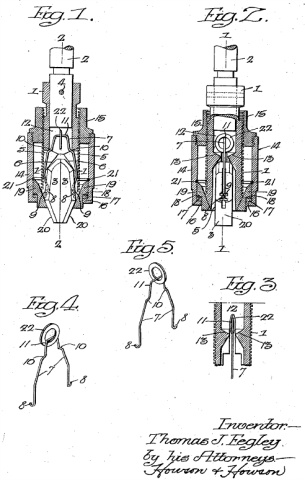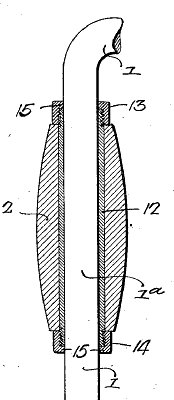Yankee Braces - A Type Study of Sorts
by George Langford
February 17, 2007 - Additions, April 21, 2008
Only a few of these are left unsold - see the list here
| North
Bros. Mfg. Co. of Philadelphia, Pennsylvania, made a line of high
quality braces, starting within the year preceding March 6, 1923, the
date on which the first patent was filed. That first patent under
which the braces were made was issued on November 6, 1923. The
last date under which a patent would be cited on the brace was
seventeen years after the date of issuance of the last of the four
patents, i.e., July 31, 1945. The patent "lifetime" of the Yankee
braces was therefore just over 22 years, ending just after the close of
World War II in 1945, whereupon the production of STEMOR braces
commenced in U.S.-occupied Japan. The principal drawings illustrating the four patents are reproduced below, in numerical order from left to right. As made by North Bros., before their acquisition by Stanley Tools, these drawings are quite exact in the qualitative sense. The only changes that I can see here are: In Fig.5 in the second drawing each of the two ratchet pawls, #17 & #18, now has a wide slot on the side facing the spring, #22. Also, in the fourth drawing, the jaws are staked at #22 in Fig.5 to hold the spreader spring, Fig.4, but all the springs that I have seen continue to use the spring & washer combination in the third drawing, Fig's 4 & 5. That said, the springs do change their detailed outlines somewhat, some looking like the third patent's drawing, and some looking like the fourth patent's drawing, but always with the third patent's washer. The later jaws have a cored hole at the end of the slot in addition to their interlocking outlines, which is far more |
secure
than the four staked spots in the early jaws,
which wear out and then let the spring pop out of the groove.
Eventually, three patents were issued to Thomas J. Fegley and George O. Leopold, who then assigned them to their employer, North Bros. Mfg. Co. Thomas J. Fegley was the sole inventer of the remaining patent, No. 1,617,998.
Google Patents will find
these for you in a flash; alternatively, click on any one of the drawings
below to locate that entire patent.
If your Yankee brace is giving you fits, see taking apart and putting together a Yankee brace. Even though the procedure strictly applies to braces later made entirely by Stanley, the functionality is the same. Many of the images in the listed groups are secondarily resized (by Mozilla Firefox) and can be seen full size by right-clicking on the images and selecting "View Image" in the pop-up menu. (Not in Internet Explorer.) |
||||||||||||||||||||
|
|
||||||||||||||||||||
| In the present lists of Yankee braces
(most of which are for sale) I have grouped the braces roughly
according to the time periods during which they were made. I
discovered late in the editing of this page that Group H belongs right
after Group B. Then Dave France came along with what I have to
call Group O. The
sequence is as follows: First, braces made by North Bros. with
two patent dates before
the second pair of patents was issued, then braces marked with all four
patents, then braces made with only the second pair of patent numbers
cited,
then braces with no patents cited, by which time The Stanley Works had
acquired North Bros. and moved the manufacturing operations away from
Philadelphia. Finally, I have a pair of Yankee-style, Made in
Occupied Japan braces made as virtual carbon copies of the North
Bros. braces
during the occupation of Japan by US forces under General Douglas
MacArthur after the end of World War II. By that time, all the
patents
had recently expired. In the groups listed at right, not all the
braces
conform exactly to type - differences are noted on the index pages. |
|







